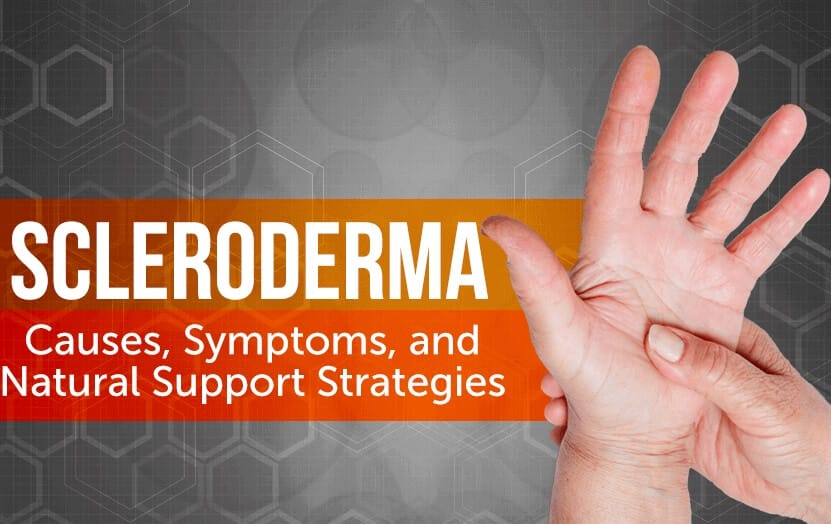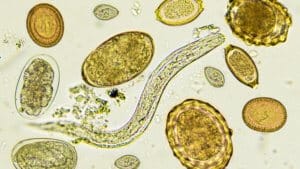Scleroderma – A Functional Medicine Approach

Scleroderma – A Functional Medicine Approach
Scleroderma is a rare, chronic autoimmune, connective tissue disease, involving the hardening and tightening of the skin and connective tissues. The Natural Treatment of scleroderma is possible through calming the immune system, removing triggers and balancing the gut and biochemistry. It affects people both in Perth, Australia and worldwide. Scleroderma comes from the Greek: sclero, meaning hard, and derma, meaning skin.
It affects women more often than men and most commonly occurs between the ages of 40 and 60. There are estimated to be over 6000 people with scleroderma in Australia. [1]
While there is no cure for scleroderma, a variety of natural treatments for scleroderma, in conjunction with traditional medicine, can ease symptoms and improve quality of life.
What is scleroderma exactly?
Scleroderma is an autoimmune disease, meaning that the immune system works against itself. The normal immune system protects the body by fighting off foreign invaders such as viruses and infections. In autoimmune disease, the immune system mistakes a person’s own tissues as foreign invaders and attacks, causing a myriad of problems.
In scleroderma, the immune system attack causes inflammation and triggers the body to make too much collagen as if there were an injury that needs repairing. The extra collagen in the tissues can prevent the body’s organs from functioning normally. Excess collagen causes the skin, and sometimes the internal organs, to become hard and tight. [2] Researchers are not sure what triggers this autoimmune response. Both genetics and environment may play a role.
Scleroderma varies widely in different patients, with some having only very minor problems, while others can have a very serious illness. Most patients have the milder condition.
Scleroderma can cause serious damage to your lungs, heart, kidneys, oesophagus and gastrointestinal tract. It can be life threatening but it is not contagious, infectious, cancerous or malignant. It can, however, lead to other medical issues such as muscle disorders, cancer, heart failure, scarring of the lungs, called pulmonary fibrosis, high blood pressure in the lungs (pulmonary hypertension), kidney failure and problems absorbing nutrients from food. The Natural treatment of Scleroderma can assist in easing symptoms and stopping the immune system from continually firing which continues to progress the disease.
Risk factors that can increase your chances of developing the condition include:
- being Native American
- being African-American
- being female
- using certain chemotherapy drugs such as Bleomycin
- being exposed to silica dust and organic solvents [3]
Types of scleroderma
There are two main types of scleroderma – localised and systemic.
In some people, scleroderma affects only the skin. This is known as localised scleroderma.
In others, scleroderma also harms other parts of the body, such as blood vessels, internal organs and the digestive tract. This is known as systemic scleroderma.
Localised Scleroderma
Localized scleroderma is usually relatively mild and about 70% of people have this type of scleromerma. It affects only the skin, although it can spread to the muscles, joints and bones. The internal organs aren’t typically affected by localized scleroderma and it rarely becomes a systemic condition.
There are two forms of localized scleroderma:
- Morphea: This occurs when discoloured patches form on the skin. These patches are varied in size, colour and shape, and they have a waxy appearance.
- Linear scleroderma: This occurs streaks or bands of hard, thick skin develop on the arms and legs. When the streaks form on the head or neck, this is called en coup de sabre because it resembles the wound of a saber or sword.
Systemic Scleroderma
Systemic scleroderma can be broken down into two main types: diffuse and limited.
Systemic scleroderma is associated with skin thickening and tightness that comes on quickly and spreads to more skin areas than in limited scleroderma. It affects the connective tissue in many parts of the body, including the skin, muscles, joints, bones, blood vessels, heart, gastrointestinal tract, oesophagus, lungs and kidneys.
Diffuse scleroderma
This form affects many parts of the body. Not only can it affect the skin, but it also can affect many internal organs, hindering digestive and respiratory functions, and causing kidney failure. Systemic scleroderma can sometimes become serious and life-threatening.
This is the most severe type for people who experience symptoms in their internal organs, which begin to harden. Approximately 30% of patients have this form.
Limited scleroderma
Sometimes, limited scleroderma is called “CREST,” which stands for the first letters of five common features of the illness:
- Calcinosis: When the formation of calcium deposits cause small, white lumps to form under the skin of the fingers and other areas of the body.
- Raynaud phenomenon: When areas of the body, like the fingers and toes, feel numb and cold when exposed to cold temperatures or stress. This is caused by limited blood circulation after smaller arteries that supply blood to the skin begin to narrow.
- Esophageal dysfunction: When the skin in the esophagus hardens, it makes the muscles less functional and makes swallowing more difficult.
- Sclerodactyly: When the buildup of fibrous tissue causes the skin to tighten so much that you can no longer curl your fingers and you lose mobility.
- Telangiectasia: When you develop threadlike red lines on the skin because the blood vessels near the surface of the skin dilate. [4]
Patients with limited scleroderma do not experience kidney problems. The skin thickening is restricted to the fingers, hands, forearms, feet and legs. Digestive involvement is confined mostly to the oesophagus. Among later complications, pulmonary hypertension, which can develop in 20% to 30% of cases, can be potentially serious. [5]
Signs and symptoms of scleroderma and the Natural treatment of Scleroderma
Signs and symptoms vary, depending on which type of scleroderma you have and which organs it has affected. Symptoms can include:
Systemic scleroderma may only affect the skin in the early stages of the disease. You may notice your skin thickening and shiny areas developing around your mouth, nose, fingers, and other bony areas.
As the condition progresses, you may begin start to have limited movement of the affected areas. Other symptoms include:
- hair loss
- calcium deposits, or white lumps under the skin
- small, dilated blood vessels under the skin’s surface
- joint pain
- shortness of breath
- a dry cough
- diarrhea
- constipation
- difficulty swallowing
- esophageal reflux
- abdominal bloating after meals
- Raynaud’s phenomenon (spasms of the blood vessels in your fingers and toes. Then, your extremities may turn white and blue when you’re in the cold or feeling extreme emotional stress) [6]
Natural Treatment of Scleroderma
There are things you can do to manage your scleroderma, natural treatment of scleroderma includes:
- To help manage Raynaud’s phenomenon, avoid exposure to cold temperatures, dress warmly and don’t smoke as these all contribute to the worsening of the phenomenon.
- Incorporate regular, gentle exercise into your daily life to help keep your joints moving, improve blood flow, strengthen your muscles and improve overall health.
- Manage your stress – this will help you cope with the demands and challenges of the condition.
- Get plenty of rest.
- Drink plenty of water.
- Apply lotions such as raw coconut oil or shea butter.
- Perform gentle stretches and yoga to keep skin and joints flexible.
- Eat a balanced diet to help provide you with better energy levels, help to maintain your weight, and give you a greater sense of wellbeing [7]
- Repair your gut and restore your microbiome balance to enable optimal immune function. Take a probiotic supplement that contains Lactobacillus acidophilus or bifidobacterium to help maintain gastrointestinal health.
- Remove gluten grains and legumes from your diet as they cause inflammation which leads to leaky gut. Some people also find removing dairy products beneficial for easing symptoms. Following an AIP diet
- Take glutathione, a powerful antioxidant, to enable detoxification. Research has shown that there is a link between toxic chemicals and the incidence of scleroderma.[8]
· Ensure adequate intake of Vitamin D – in a study of 51 patients conducted in 2016, researchers determined low levels of vitamin D frequently occur in systemic sclerosis. The authors concluded that poor vitamin status seems to be linked to a more aggressive disease with multivisceral and severe organ involvement, particularly of the lungs and heart.
· Ensure adequate intake of Vitamin E – According to a 2009 study of 27 patients, application of vitamin E gel may reduce healing time and soothe pain in people with digital ulcers caused by systemic scleroderma.[9]
- Take omega-3 fatty acids, such as fish oil, daily. Omega-3 fatty acids help improve blood flow, and a few studies suggest they may reduce symptoms of Raynaud’s phenomenon and help people better tolerate cold temperatures. Cold-water fish, such as salmon or halibut, are good sources.
- Massage and physical therapy can improve circulation.
- Take bromelain which can help reduce pain and inflammation.
- Take turmeric to reduce inflammation and relieve pain.
- Take gotu kola for blood vessel health and circulation. Some purified extracts of gotu kola seem to reduce symptoms of scleroderma. [10]
How we can help
Scleroderma can have a significant impact on the quality of a person’s life. In some people, symptoms develop quickly for the first few years and continue to get worse. However, in most people, the disease gets worse slowly, over time.
At Advanced Functional Medicine, our practitioners are here to help you reduce your symptoms through the support of scleroderma. Balancing the biochemistry, calming the immune system and removing immune system triggers are part of a functional medicine approach.
Contact us via the form below or call us to find out more




